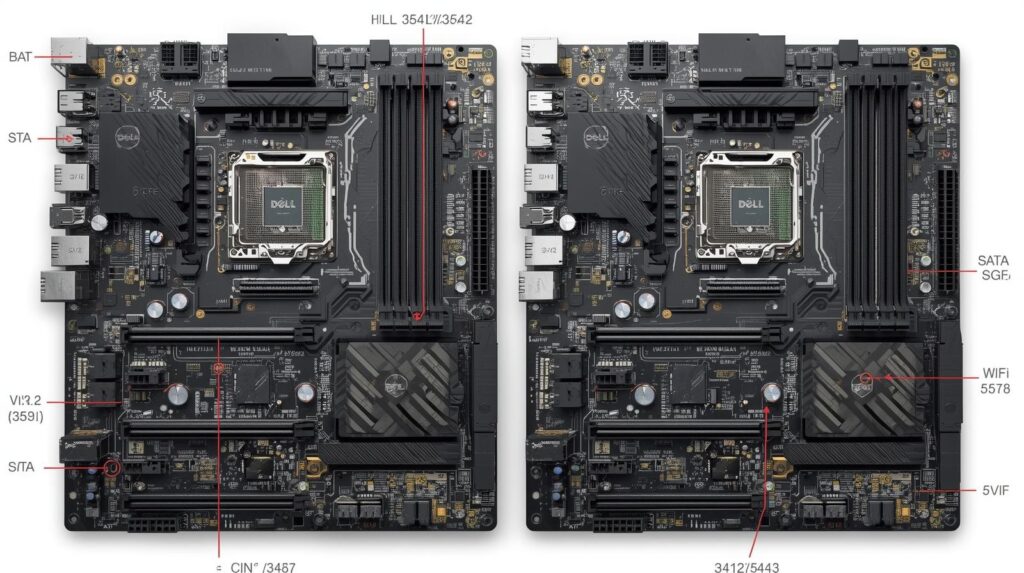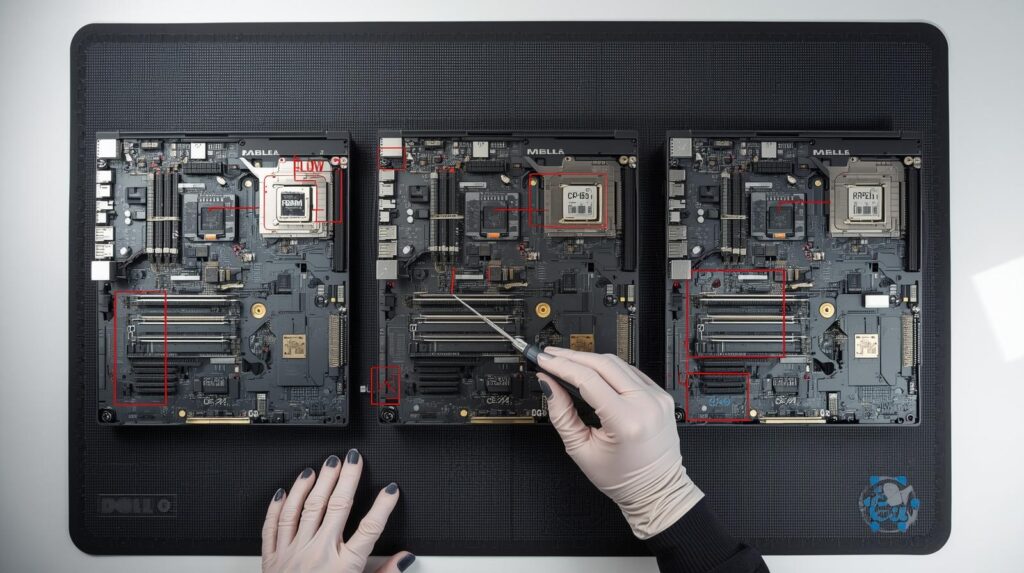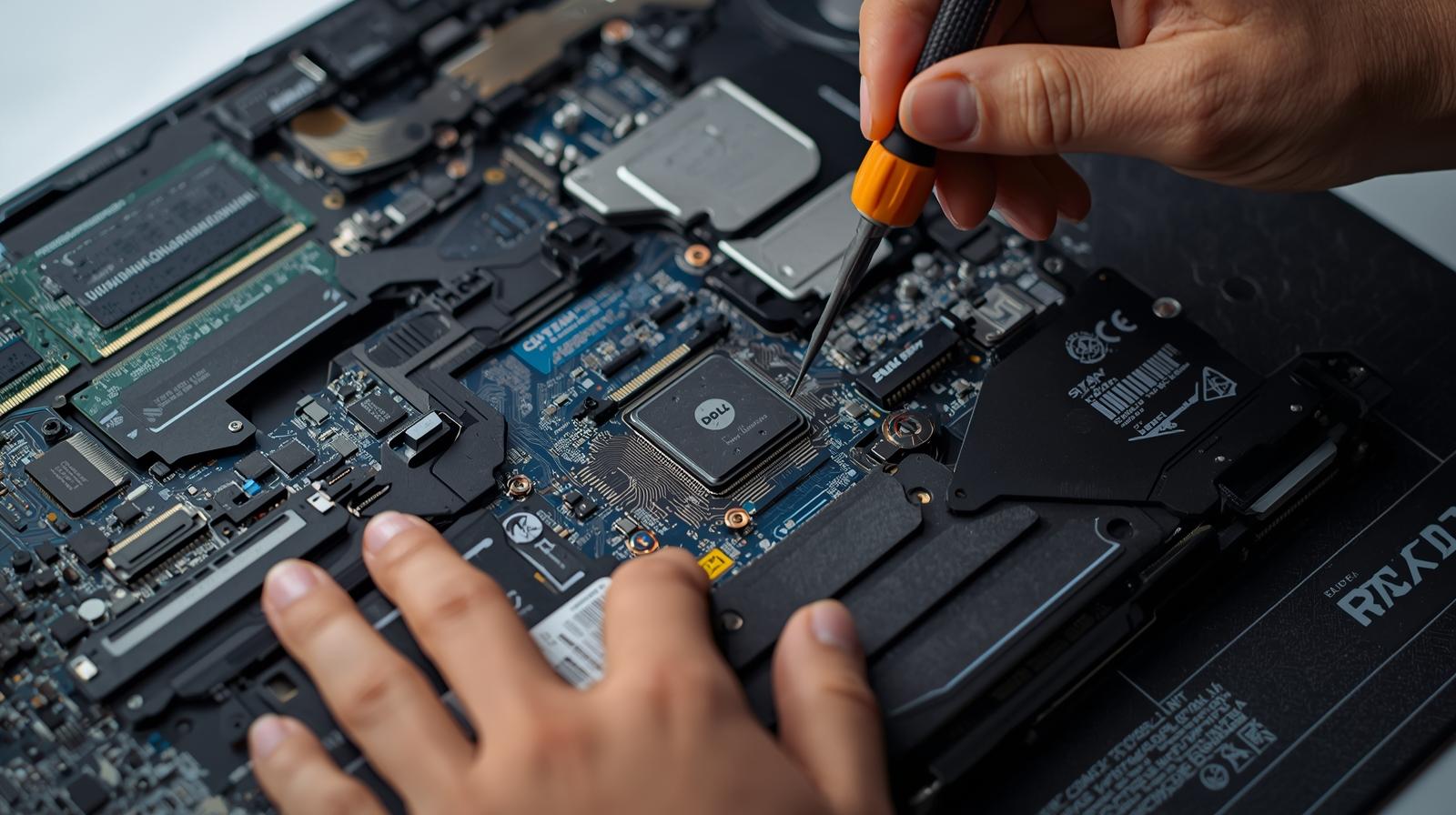I wasted a week trying to figure out why my Dell 3543 kept restarting randomly. I thought it was a software issue, I tried updates, scans, everything. At the end, it was the motherboard. I was shocked because I assumed such laptops were reliable. That experience changed how I approach laptop maintenance.
When it comes to Dell 3542, 3543, 3442, and 3443, the motherboard is not just a piece of hardware; it is the heart of everything. In this guide, I want to walk you through every detail I have learned over months of troubleshooting, upgrading, and even replacing these boards. From specifications to common problems, from buying tips to step-by-step replacements, you will get a full picture.
Overview of Dell 3542, 3543, 3442, 3443 Motherboards

What is a Laptop Motherboard
I remember the first time I opened a Dell 3442 to see the motherboard. It looked like a small city with chips, ports, and wires crammed together. The motherboard connects the processor, RAM, storage, graphics, and all peripherals.
Without it, nothing works. Over time, I realized that many performance issues, crashes, and upgrade limitations trace back to this one component. You can think of it as the central nervous system of your laptop. If it is outdated or faulty, even a powerful CPU or GPU will feel crippled. I have learned that checking the motherboard first saves a lot of frustration.
Dell 3542 vs 3543 vs 3442 vs 3443 Motherboard Differences
I had both a 3542 and a 3443 at one point. The 3542 supported slightly faster RAM and had a more advanced chipset, which made a difference when I tried running multiple heavy applications. The 3443 felt a little limited, especially in graphics performance. To make it clear, I made a small comparison based on my experience:
| Model | CPU Support | Max RAM | GPU Compatibility | Ports Available |
| 3542 | Intel i3/i5/i7 4th Gen | 8GB | Integrated & Some Dedicated | USB 3.0, HDMI, LAN |
| 3543 | Intel i3/i5/i7 4th Gen | 16GB | Integrated & Dedicated | USB 3.0, HDMI, LAN, Card Reader |
| 3442 | Intel i3/i5 | 8GB | Integrated Only | USB 2.0, HDMI, LAN |
| 3443 | Intel i3/i5/i7 4th Gen | 16GB | Integrated & Some Dedicated | USB 3.0, HDMI, LAN |
Seeing this table after juggling upgrades saved me a lot of guesswork. I was frustrated before because I kept assuming all models were the same internally. They are not. Pay attention to this.
Key Features of Dell 3542/3543/3442/3443 Motherboards

Processor Compatibility
The processors these boards support matter a lot. On my 3543, I tried replacing the i5 with an i7 and it worked, but the 3442 would not handle the same upgrade. The socket type matters as well.
I had to double-check BGA versus PGA, and I spent an afternoon confirming the CPU generations that each motherboard could actually handle. Do not trust generic online listings; check the Dell service tag or the official documentation. That saved me from buying an incompatible chip worth over ₹12,000.
RAM and Storage Support
Memory upgrades are usually the easiest way to boost performance, but these Dell boards have limitations. On my 3543, the RAM limit is 16GB using DDR3L, while the 3542 maxes out at 8GB. Storage is another story. I tried adding an SSD to my 3443. It worked perfectly, but the 3442 needed an adapter, which was annoying.
Count the slots, check the maximum RAM, and remember that storage interfaces differ slightly. I learned this the hard way when I wasted time trying a standard M.2 SSD on a board that only accepted SATA-based storage.
Graphics and Display Support
Integrated graphics work fine for regular tasks, but when I tried gaming on the 3543, the dedicated GPU made a huge difference. The 3442 never handled higher resolutions well. If you care about display performance or connecting to external monitors, know the limitations.
The ports and resolutions supported vary, and I spent a frustrating day trying to get dual monitors to work on a 3442 before realizing the motherboard simply did not support it fully.
Connectivity and Ports
I always check ports first. USB 3.0, HDMI, LAN, and Wi-Fi module slots can make or break a setup. I was shocked when my 3542 failed to recognize a USB 3.0 drive.
The motherboard was the culprit. Card reader support also varies. Small details like this caused me headaches when transferring files during client work. Keep a close eye on what each model actually has.
Expansion and Upgrade Options
Upgrades feel great until you hit the motherboard limits. RAM and storage are usually fine, but CPU or GPU upgrades often hit a wall. I learned that trying to push a 3442 beyond 8GB RAM was pointless. Reading the specs is one thing, seeing real-life results is another. I now always check the board first before planning upgrades.
Common Problems and Troubleshooting

Laptop Not Powering On
This drives me crazy. Once, my 3543 refused to turn on. I checked the battery, the charger, the RAM. Nothing worked. Eventually, the motherboard was the issue. Step one is always basic checks: power jack, battery, and RAM seating. Then move on to motherboard inspection. If you do this too late, you waste a ton of time like I did.
Overheating or Performance Issues
Dust and thermal paste can ruin performance. I spent months wondering why my 3542 overheated even under light loads. Opening the laptop, cleaning the fan, and reapplying thermal paste solved it. BIOS updates also help. Don’t underestimate the software side affecting motherboard behavior. It blew my mind how much difference a tiny BIOS patch could make.
USB/Port Malfunctions
I have had USB ports fail mid-project. On two occasions, it was the motherboard, not the peripherals. Fixes include careful inspection or replacement. I learned that throwing new peripherals at the problem does not solve it. The board holds the answers.
Replacement and Buying Guide
How to Identify Your Dell Laptop Motherboard Model
This confused me for months. You cannot just guess from the laptop model. I learned to check the BIOS or service tag. Visual inspection also helps, but I prefer official confirmation. Saves from buying the wrong board.
Where to Buy Genuine Dell Motherboards
I wasted money on an online marketplace once. Counterfeit boards do exist. Dell official parts store is reliable, though pricier. Verified sellers on Amazon or Flipkart also work if you confirm authenticity. Avoid cheap alternatives; they cost more in repairs than you save.
Step-by-Step Replacement Guide
Replacing the motherboard is scary. I always use anti-static tools and a dedicated workspace. Tools needed are basic screwdrivers and sometimes a plastic spudger. Follow the order: remove battery, unscrew panels, disconnect cables, replace board, reconnect everything carefully. One wrong connection and you risk total failure. I speak from experience.
Conclusion
I learned the hard way that the motherboard determines so much about your laptop experience. Performance, upgrades, even stability depends on it. If I were starting today, I would first check the motherboard specs before buying or upgrading anything. My personal recommendation:
stick to official or verified parts, double-check compatibility, and do not rush replacements. This guide saved me weeks of frustration. Now I am curious: what was your worst motherboard experience? I would love to hear your story. If you want to explore more guides and detailed comparisons on motherboards, check out our Complete Motherboard Guide | Types, Features, and Setup for PC Builders.
FAQs
Can the motherboard BIOS be updated on Dell 3542/3543/3442/3443?
Yes, the BIOS can be updated. Check Dell’s official website for the latest BIOS version for your specific model. Updating can improve stability and compatibility.
Do these motherboards support dual-channel RAM?
Most 3542/3543/3442/3443 boards support dual-channel RAM, but it depends on how many slots you populate and the RAM configuration.
Can I replace the onboard graphics on these motherboards?
No, the integrated graphics are part of the CPU or motherboard and cannot be replaced. Only certain 3543/3443 models support dedicated graphics upgrades.
Are these motherboards compatible with Linux?
Yes, most hardware works with popular Linux distributions, but check driver availability for Wi-Fi, graphics, and audio components.
How long do these motherboards typically last?
With normal use, they can last 5 to 7 years. Factors like overheating, power surges, or physical damage can reduce lifespan.
Do these motherboards have M.2 slots for NVMe SSDs?
Some 3543 and 3443 boards have M.2 slots, but 3542 and 3442 usually only support SATA storage. Always check your exact model.
Can I overclock the CPU on these Dell laptops?
No, these motherboards do not support overclocking. Dell laptops are not designed for overclocking and it can cause permanent damage.
What warranty coverage is available for these motherboards?
Official Dell motherboards usually come with 1-year warranty. If purchased from verified third-party sellers, warranty varies and should be confirmed before buying.

